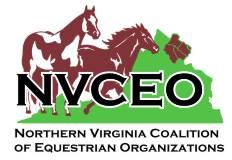Sharing the trail
with horses:
Understanding their instincts
From the Summer 2003 issue of
Trail Tracks, the national newsletter of American Trails.
By Judi Daly Author of Trail Training for the Horse and Rider
The comic strip "Born Loser" one day had a strip that I've never
forgotten. A man was walking down the street was thinking something
like, "My great-grandfather loved horses but was afraid of trains. My
grandfather was loved trains but was afraid of cars. My father loved
cars but was afraid of airplanes. I love airplanes, but I'm afraid of
horses."
Photo courtesy of Clark Collins It has stuck in my head for years,
and I'm reminded of it whenever I am riding on the trail and someone
reacts to my horse in an inappropriate way. At one time, the average
person knew basically how horses behave, but these days most people
think horses are oversized dogs that can be ridden.
Put in a nutshell-- horses are afraid of everything. Wild horses
stayed alive by running first and asking questions later. If they are
trapped, they will fight.
With patient training, we help our horses overcome their natural
tendencies, but we can never fully desensitize them to everything. I
train my horses not to be afraid of deer by allowing them to watch the
deer and even follow them if possible. They treat deer with curiosity or
indifference when they see them, but if a deer should suddenly leap out
in front of them, it can mean trouble.
The same applies to bikes, hikers, dog walkers, joggers, and all
other sorts of human trail users. We do our best to train our horses
that there is nothing to be afraid of, but if a human does something
unpredictable, our horses may act in a predictably horse-like manner--
run.
"Other trail users can help us by acting in a predictable and
non-threatening way." Other trail users can help us by acting in a
predictable and non-threatening way. If possible, when you see a horse
and rider coming, step off to the side of the trail to allow them to
pass. Don't hide. To a horse, someone hiding behind a tree is suspicious
behavior. Say, "Hello." As silly as this sounds, it helps a lot. If a
horse is confused as to what you are doing, hearing your voice will
help.
Be extra careful on hills. If you can, position yourself so you are
below the horse instead of above him. Remember, a frightened horse will
run away from what is scaring him. Running down a hill is far, far worse
than running up a hill.
Dogs are another potential fright. Hold your dog closely, and try to
keep him quiet and still. Once a loose dog ran at one of my horse's hind
feet as I was leading him. Since I wouldn't let my horse run away from
the dog, naturally he kicked out. His heels did make contact with the
dog, who fortunately wasn't seriously hurt. Keeping your dog on a leash
around horses is smart for another reason: a dog that has never seen a
horse may panic and run away. I've seen this happen.
Bikes can also be very frightening to horses because they are so
quiet, yet move very fast. Never pass a horse from behind. Call out that
you want to pass, so the rider can turn the horse around to face the
bike. Then the bike can pass safely. If the horse is facing the
"monster," there is no place to run. If there is a horse coming towards
you, it is best to just stop your bike and allow the horse to pass you.
Don't forget to say "hello."
Motorized vehicle riders should stop their vehicle, turn off the
engine and let the horse go by. Let him get way down the trail before
you start back up, as a sudden engine noise has spooked many a horse. If
you want to pass a horse up that you are approaching from behind, do the
same as suggested for bicyclists.
Horses, like people, each have their own personality. Some are
naturally calmer than others regardless of their training. One day, as I
was riding my Paint, Mingo, a bike came up the trail from behind. Mingo
stopped, turned his head, and simply watched the bike go by. The rider
didn't say a word or slow down at all. The cyclist was lucky. If I was
on my Morab, Cruiser, he might have dashed forward to get out of the
way. And if he had done the same to my sister when she was riding her
horse, Ranger, the cyclist would have seen a pair of heels flying
towards him.
We know what we need to do with our individual horses. I don't worry
when I ride Mingo, I turn Cruiser to face anyone approaching us so he
won't bolt, and my sister positions Ranger so he won't hit anyone if he
kicks. Equestrians want to help all of us on the trails know how to act
in a safe and predictable manner-- not only is it much less likely
someone will get hurt, but you might make a new friend.
Judi Daly is the author of Trail Training for the Horse and Rider.
Visit Judi's website at
http://trailtraining.bigstep.com.
August 2003
|

